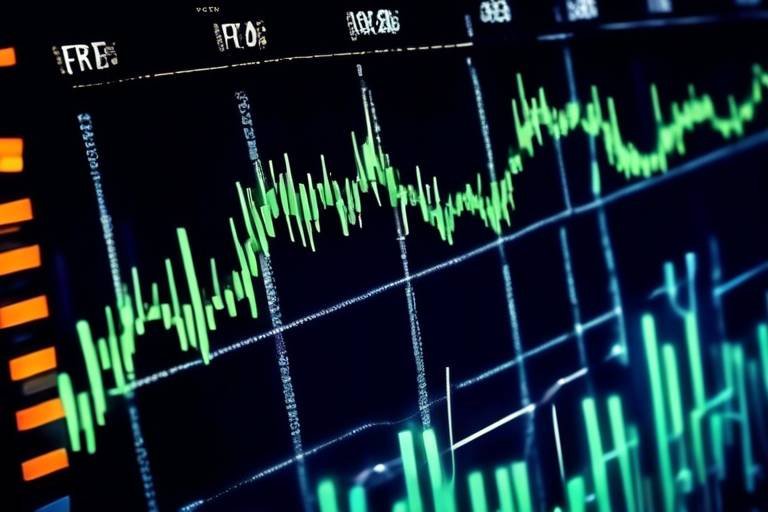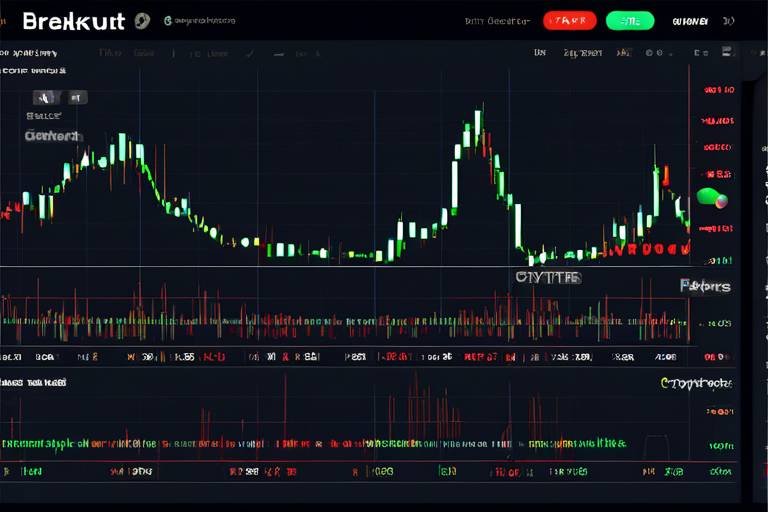How to Use Price Action to Make Informed Trading Decisions
In the fast-paced world of trading, making informed decisions can feel like trying to catch smoke with your bare hands. However, one powerful tool that traders can utilize is price action trading. This approach focuses on the movement of a security's price over time, allowing traders to interpret market sentiment and make decisions based on real-time data rather than relying solely on indicators or external news. By understanding price action, traders can gain insights into the market's behavior, enabling them to navigate the complexities of trading with greater confidence.
Price action trading is significant because it strips away the noise and distractions that often cloud judgment. Think of it as viewing a painting without the frame—you're left with the raw essence of the artwork. Similarly, by concentrating on price movements, traders can identify patterns and trends that indicate potential future price behavior. This method not only enhances decision-making but also fosters a deeper understanding of market dynamics, which is crucial for anyone looking to succeed in trading.
As we dive deeper into the world of price action, we’ll explore its fundamental principles, including trends, support and resistance levels, and the psychological aspects of trading. Each of these elements plays a pivotal role in helping traders formulate strategies that align with market movements. So, buckle up and get ready to uncover the secrets of price action trading!
Price action refers to the movement of a security's price over time, and it’s the heartbeat of the financial markets. By observing how prices fluctuate, traders can glean insights into market sentiment and potential future movements. Imagine standing on the shore and watching the waves; the way they rise and fall can tell you a lot about the weather ahead. Similarly, price action can reveal the underlying forces driving market changes.
The importance of price action lies in its ability to provide a clear picture of market trends without the clutter of complex indicators. Traders who master this skill can make quicker, more informed decisions. They learn to read the market like a book, interpreting each price movement as a chapter filled with clues about traders' intentions. This understanding is crucial for effective decision-making, as it allows traders to anticipate market shifts and adjust their strategies accordingly.
At the heart of price action trading are several key principles that every trader should understand. These include trends, support and resistance levels, and the psychology of the market. Each principle serves as a building block for developing a robust trading strategy.
Recognizing trends is vital in price action trading. Trends can be classified as bullish (upward) or bearish (downward), and understanding their implications is essential for effective trading strategies. Just like a river flows in one direction, so does the market, and identifying the direction of this flow can significantly impact trading outcomes.
To identify bullish and bearish trends, traders often rely on price charts and various indicators. A bullish trend is characterized by higher highs and higher lows, while a bearish trend features lower highs and lower lows. By analyzing these patterns, traders can align their strategies with the prevailing market sentiment, increasing their chances of success.
Spotting potential trend reversals is another critical aspect of price action trading. Just as a car might signal a turn before changing direction, the market often provides clues about impending shifts. Traders look for specific price patterns or candlestick formations that indicate a possible reversal, allowing them to adjust their strategies proactively.
Support and resistance levels are crucial in price action trading. Support refers to a price level where a downtrend can be expected to pause due to a concentration of demand, while resistance is where an uptrend may pause due to a concentration of supply. Identifying these levels helps traders make informed decisions about entry and exit points in their trades.
Candlestick patterns provide valuable insights into market sentiment. Each candlestick represents a specific time period and conveys crucial information about price movements within that timeframe. By learning to interpret these patterns, traders can predict future price movements with greater accuracy.
Some of the most common candlestick patterns include:
- Dojis: These indicate indecision in the market.
- Hammers: Often signal a potential reversal at the bottom of a downtrend.
- Engulfing patterns: Suggest a strong reversal in market sentiment.
Learning how to interpret candlestick signals effectively allows traders to make timely decisions based on market behavior and price action dynamics. By combining candlestick analysis with other price action techniques, traders can develop a comprehensive trading strategy that adapts to changing market conditions.
Q: What is price action trading?
A: Price action trading focuses on the movement of a security's price over time, allowing traders to make decisions based on real-time data rather than external indicators.
Q: How can I identify trends in price action?
A: Traders can identify trends by analyzing price charts for higher highs and higher lows (bullish) or lower highs and lower lows (bearish).
Q: What are support and resistance levels?
A: Support levels are price points where a downtrend may pause due to increased demand, while resistance levels are points where an uptrend may pause due to increased supply.
Q: Why are candlestick patterns important?
A: Candlestick patterns provide insights into market sentiment and can help predict future price movements, making them valuable for traders.

Understanding Price Action
Price action is a term that refers to the movement of a security's price over time. It's like the heartbeat of the market, pulsing with the emotions and decisions of traders. Understanding price action is crucial because it allows traders to make informed decisions based on historical price movements rather than relying solely on indicators or external news. When you grasp the essence of price action, you can decode the market's language and anticipate potential future movements.
One of the most significant aspects of price action is its ability to reflect market psychology. The price movement captures the collective sentiment of all market participants, showing whether they are feeling bullish (optimistic) or bearish (pessimistic). For instance, if a stock's price is consistently rising, it indicates that buyers are in control, and the market sentiment is positive. Conversely, a declining price suggests that sellers are dominating the market, and fear may be creeping in. This dynamic interplay is what makes price action so fascinating and essential for traders.
Price action can be interpreted through various methods, but at its core, it involves analyzing price charts. These charts visually represent price movements over different time frames, allowing traders to identify patterns, trends, and levels of support and resistance. By observing how prices behave in response to these levels, traders can make educated guesses about future movements. It's akin to reading a story where each price movement tells a part of the tale, guiding you toward a conclusion.
Moreover, understanding price action means recognizing that it is not just about numbers; it’s about context. For instance, a price spike might indicate a significant event, such as earnings reports or geopolitical events, that could influence trader behavior. Thus, the ability to interpret the context behind price movements can provide traders with a competitive edge. In summary, mastering price action is like learning to read the pulse of the market, allowing you to make decisions that align with the underlying trends and sentiments.

Key Principles of Price Action Trading
When it comes to price action trading, understanding its key principles is essential for any trader looking to navigate the financial markets successfully. Price action trading revolves around the analysis of historical price movements to make informed trading decisions. This approach emphasizes the importance of price movements over technical indicators, enabling traders to grasp the underlying market dynamics better.
One of the fundamental principles of price action trading is recognizing trends. Trends can be classified into three categories: bullish, bearish, and sideways. A bullish trend indicates that prices are rising, while a bearish trend signifies falling prices. Sideways trends occur when prices move within a horizontal range. Identifying these trends allows traders to align their strategies with the market's momentum. For instance, a trader observing a bullish trend might consider entering long positions, anticipating further price increases.
Another pivotal principle is the concept of support and resistance levels. Support refers to a price level where buying interest is strong enough to overcome selling pressure, while resistance is where selling interest prevails over buying. These levels act as psychological barriers for traders, influencing their decisions. For example, if a stock approaches a support level, traders may see it as an opportunity to buy, expecting the price to bounce back. Conversely, if the price nears a resistance level, they might consider selling or shorting, anticipating a reversal.
Market psychology plays a crucial role in price action trading. Understanding how traders react to price movements can provide valuable insights. For instance, during periods of high volatility, fear and greed can drive prices dramatically. Traders who can read these emotional cues can capitalize on market inefficiencies. The interplay of supply and demand, influenced by trader sentiment, often leads to significant price movements, and recognizing these patterns can enhance a trader's decision-making process.
In summary, the key principles of price action trading revolve around recognizing trends, identifying support and resistance levels, and understanding market psychology. By mastering these principles, traders can develop a robust framework for making informed trading decisions. The beauty of price action trading lies in its simplicity and effectiveness, allowing traders to react swiftly to market changes without the clutter of complex indicators.
- What is price action trading? Price action trading is a method that focuses on the movement of a security's price over time, allowing traders to make decisions based on historical price data rather than relying solely on technical indicators.
- How can I identify trends in price action? Trends can be identified by observing price charts for consistent upward (bullish) or downward (bearish) movements. Traders often use trendlines to visually represent these trends.
- What are support and resistance levels? Support levels are price points where buying interest is strong, preventing prices from falling further, while resistance levels are where selling interest is strong, preventing prices from rising higher.
- Why is market psychology important in price action trading? Market psychology influences trader behavior and can lead to significant price movements. Understanding how emotions like fear and greed affect market dynamics can help traders make better decisions.

Trends in Price Action
Understanding trends in price action is like having a compass in the unpredictable wilderness of the financial markets. Trends serve as the backbone of price action trading, guiding traders through the complexities of price movements. Essentially, a trend is the general direction in which the price of an asset is moving. There are three main types of trends: uptrends, downtrends, and sideways trends. Recognizing these trends is crucial for traders, as they can significantly influence trading strategies and potential profit margins.
In an uptrend, prices consistently make higher highs and higher lows, indicating a bullish market sentiment. For instance, think of a rising tide that lifts all boats; in this scenario, traders can look for opportunities to buy as the price continually ascends. Conversely, a downtrend is characterized by lower highs and lower lows, akin to a sinking ship; here, traders might consider selling or shorting their positions as prices are expected to continue declining. The sideways trend, on the other hand, represents a market in consolidation, where prices fluctuate within a narrow range. This type of trend can be frustrating, but it also presents unique opportunities for traders who can identify breakout points.
To effectively identify these trends, traders often rely on price charts and various indicators. One popular method is using trend lines. By drawing a line that connects the higher lows in an uptrend or the lower highs in a downtrend, traders can visualize the trend's direction. Additionally, moving averages can smooth out price fluctuations and help traders spot trends more easily. For example, if the price is consistently above a 50-day moving average, it might suggest an uptrend, while prices below this average could indicate a downtrend.
Moreover, it's essential to recognize that trends can change, and understanding trend reversals is equally important. Spotting signs of a potential reversal can help traders adjust their strategies before significant market shifts occur. Common indicators of trend reversals include significant price levels, candlestick patterns, and volume changes. For instance, if prices break through established support or resistance levels, it can signal a shift in market sentiment, prompting traders to reconsider their positions.
In conclusion, mastering the art of identifying and interpreting trends in price action is vital for any trader looking to make informed decisions. By understanding the different types of trends and their implications, traders can better navigate the complexities of the financial markets and enhance their chances of success. Remember, just like a skilled sailor reads the wind and waves, a savvy trader reads the price action to steer their trading strategies in the right direction.
- What is a trend in price action trading? A trend refers to the general direction in which the price of an asset is moving, which can be upward, downward, or sideways.
- How can I identify trends in the market? Traders often use price charts, trend lines, and moving averages to identify trends and make informed trading decisions.
- What are trend reversals? Trend reversals occur when the price changes direction, indicating a potential shift in market sentiment that traders should be aware of.
- Why are trends important in trading? Trends help traders align their strategies with market movements, increasing the likelihood of successful trades and minimizing risks.

Identifying Bullish and Bearish Trends
Identifying trends is a fundamental skill for any trader looking to navigate the financial markets successfully. At its core, a bullish trend is characterized by rising prices, while a bearish trend indicates falling prices. Understanding these trends can significantly enhance your trading strategy, allowing you to make informed decisions based on market behavior.
To effectively identify bullish and bearish trends, traders often rely on price charts, which visually represent price movements over time. The most common types of charts include line charts, bar charts, and candlestick charts. Among these, candlestick charts are particularly popular due to their ability to convey a wealth of information in a compact format. They not only show the open, high, low, and close prices but also provide insights into market sentiment through various formations.
When analyzing price charts, look for the following key indicators:
- Higher Highs and Higher Lows: In a bullish trend, prices consistently make higher highs and higher lows. This pattern indicates that buyers are in control, pushing prices upward.
- Lower Highs and Lower Lows: Conversely, in a bearish trend, prices create lower highs and lower lows. This suggests that sellers dominate the market, driving prices down.
Additionally, traders often use moving averages to confirm trends. A simple moving average (SMA) can help smooth out price fluctuations, making it easier to spot the overall direction of the market. For instance, when the price is above the SMA, it may indicate a bullish trend, while prices below the SMA can signal a bearish trend.
Another effective method for identifying trends is through the use of trend lines. By connecting the lows in an uptrend or the highs in a downtrend, traders can visually represent the direction of the market. A break of these trend lines can often signal a potential reversal, prompting traders to reassess their positions.
It's essential to remember that trends do not last indefinitely. Market conditions change, and trends can reverse unexpectedly. Therefore, being aware of potential trend reversals is just as crucial as identifying the current trend. Traders should look for signs such as divergence in momentum indicators, which can indicate that the prevailing trend may be losing strength.
In summary, identifying bullish and bearish trends requires a combination of technical analysis, chart interpretation, and a keen understanding of market psychology. By honing these skills, traders can better align their strategies with market movements, increasing their chances of making profitable trades.
Q: What is the best way to identify a bullish trend?
A: Look for higher highs and higher lows on your price chart, as well as confirmation from moving averages.
Q: How can I tell if a bearish trend is reversing?
A: Watch for signs such as divergence in momentum indicators or a break of established trend lines.
Q: Are candlestick patterns useful for identifying trends?
A: Absolutely! Candlestick patterns can provide valuable insights into market sentiment and potential trend reversals.

Trend Reversals
In the world of trading, understanding is akin to having a secret weapon in your arsenal. Just imagine being able to predict when a bullish market is about to turn bearish or vice versa. This skill can significantly enhance your trading strategy and ultimately lead to more profitable outcomes. But how do you spot these elusive trend reversals? Well, it all starts with keen observation of price action and the use of various indicators.
Trend reversals occur when the prevailing market trend changes direction. For instance, a bullish trend, characterized by rising prices, may suddenly shift to a bearish trend, where prices start to decline. Recognizing these shifts early can be the difference between a successful trade and a costly mistake. Traders often look for specific signs that indicate a potential reversal, such as divergences between price and momentum indicators, significant candlestick patterns, or key support and resistance levels being breached.
One way to spot a potential trend reversal is by analyzing price patterns on charts. For example, a double top formation often signals a bearish reversal after a strong uptrend. Conversely, a double bottom suggests a bullish reversal following a downtrend. These patterns, when combined with volume analysis, can provide powerful insights into market sentiment. But remember, no single indicator or pattern is foolproof. It’s essential to consider multiple factors before making any trading decisions.
Another critical aspect to consider is the market psychology behind trend reversals. Traders’ emotions play a significant role in price movements. When a trend is strong, traders may become overly confident, leading to complacency. However, as prices begin to show signs of weakness, fear can set in, prompting a rush to sell and further accelerating the reversal. This psychological dynamic is why it’s crucial to remain vigilant and not let emotions cloud your judgment.
To aid in your understanding of trend reversals, here's a simple table summarizing some common reversal patterns:
| Pattern | Description | Indication |
|---|---|---|
| Double Top | Two peaks at roughly the same price level | Bearish reversal |
| Double Bottom | Two troughs at roughly the same price level | Bullish reversal |
| Head and Shoulders | A peak (head) between two lower peaks (shoulders) | Bearish reversal |
| Inverse Head and Shoulders | A trough (head) between two higher troughs (shoulders) | Bullish reversal |
In conclusion, mastering the art of identifying trend reversals can significantly bolster your trading strategy. It requires practice, patience, and a willingness to learn from both successes and failures. Always remember to combine technical analysis with a solid understanding of market psychology to make the most informed decisions possible. So, the next time you’re analyzing a chart, keep an eye out for those potential reversals – they may just hold the key to your next successful trade!
- What is a trend reversal? A trend reversal occurs when the direction of a market trend changes, either from bullish to bearish or vice versa.
- How can I identify a trend reversal? Look for specific price patterns, divergences in momentum indicators, and breaches of support and resistance levels.
- Are trend reversals always reliable? No, while they can provide valuable insights, no single indicator or pattern guarantees a reversal will occur.
- What role does market psychology play in trend reversals? Traders' emotions can drive price movements; understanding this can help you anticipate potential reversals.

Support and Resistance Levels
Understanding is fundamental for anyone looking to excel in price action trading. These levels act as psychological barriers where the price tends to stop and reverse. Think of support as the floor of a room—when the price falls to this level, it often bounces back up, much like a ball hitting the ground. On the other hand, resistance can be likened to a ceiling; when the price reaches this level, it often struggles to break through and may fall back down. Recognizing these levels can significantly enhance your trading strategy and decision-making process.
Support levels are typically identified by looking at historical price data. If a stock has repeatedly bounced back from a certain price point, that point is considered support. Conversely, resistance levels are established when a price has previously peaked and then retreated. These levels are not just random numbers; they represent where traders have previously entered or exited the market, indicating a collective sentiment among market participants.
To effectively identify these levels, traders often use a combination of price charts and technical indicators. For instance, moving averages can help smooth out price data and highlight potential support and resistance areas. Additionally, traders might look for patterns in price action, such as double tops or bottoms, which can signify the strength of these levels.
It's important to note that support and resistance levels are not set in stone. They can shift as market conditions change, influenced by various factors such as economic news, earnings reports, or geopolitical events. Therefore, staying vigilant and ready to adjust your strategy is crucial. For example, if a stock breaks through a resistance level, that level may become a new support level in the future. This concept, known as role reversal, is essential for traders to understand.
Here’s a quick table summarizing the characteristics of support and resistance levels:
| Level | Description | Market Behavior |
|---|---|---|
| Support | A price level where a downtrend can be expected to pause due to a concentration of demand. | Price tends to bounce back up after hitting this level. |
| Resistance | A price level where an uptrend can be expected to pause due to a concentration of selling interest. | Price tends to fall back down after reaching this level. |
In summary, mastering support and resistance levels is an essential skill for traders. These levels not only help in identifying entry and exit points but also provide insight into market sentiment and potential price movements. By incorporating these concepts into your trading strategy, you can make more informed decisions and potentially increase your profitability in the markets.

Using Candlestick Patterns
Candlestick patterns are like the secret language of the market. They tell a story through their shapes and colors, reflecting the emotions and decisions of traders. Understanding these patterns can give you a significant edge in making informed trading decisions. Just imagine walking into a crowded room and being able to read the mood instantly; that’s what candlestick patterns do for traders. They convey market sentiment in a visually appealing way, allowing you to anticipate potential price movements.
At their core, candlestick patterns consist of a series of individual candles, each representing price action for a specific time frame. Each candle is comprised of a body and wicks (or shadows), which illustrate the open, close, high, and low prices. The body of the candle can be filled or hollow, indicating whether the price closed higher or lower than it opened. This visual representation helps traders quickly assess bullish or bearish sentiment. For instance, a long green candle suggests strong buying pressure, whereas a long red candle indicates selling pressure.
Here are a few common candlestick patterns that traders should familiarize themselves with:
- Dojis: These candles have very small bodies and long wicks, indicating indecision in the market. They often signal potential reversals or continuation patterns.
- Hammers: These candles appear at the bottom of a downtrend and suggest a potential reversal. They have small bodies with long lower wicks, indicating that buyers stepped in after sellers pushed the price down.
- Engulfing Patterns: This pattern occurs when a larger candle completely engulfs the previous smaller candle. A bullish engulfing pattern suggests a potential reversal to the upside, while a bearish engulfing pattern indicates a possible reversal to the downside.
Understanding how to interpret these patterns is crucial for traders looking to capitalize on market movements. For example, if you spot a hammer at the bottom of a downtrend, it might be time to consider entering a long position. Conversely, if you see a bearish engulfing pattern at a resistance level, it could signal a good opportunity to go short. The key is to combine these patterns with other forms of analysis, such as support and resistance levels, to increase the probability of a successful trade.
Moreover, the context in which these patterns appear is equally important. A candlestick pattern that appears after a significant price move can carry more weight than one that forms in a sideways market. Traders often look for confirmation from subsequent candles to validate their interpretations. For instance, if a hammer is followed by a strong bullish candle, it reinforces the idea that the market is shifting in favor of buyers.
In conclusion, mastering candlestick patterns is an essential skill for any trader. They provide a visual representation of market sentiment and can help you make timely decisions based on price action dynamics. By incorporating candlestick analysis into your trading strategy, you can gain deeper insights into market behavior and improve your chances of success.
What are candlestick patterns?
Candlestick patterns are formations created by one or more candlesticks on a price chart that reflect market sentiment and can indicate potential price movements.
How can I use candlestick patterns in trading?
Traders can use candlestick patterns to identify potential reversals or continuations in the market. By analyzing these patterns in conjunction with other technical indicators, traders can make more informed trading decisions.
Are candlestick patterns reliable?
While candlestick patterns can provide valuable insights, they are not foolproof. It's essential to use them as part of a broader trading strategy that includes other forms of analysis.

Common Candlestick Patterns
Candlestick patterns are like the heartbeat of the market, providing traders with crucial insights into price movements and market sentiment. Understanding these patterns can be the difference between a successful trade and a missed opportunity. So, what are the most common candlestick patterns you should be aware of? Let’s dive into a few that can significantly impact your trading strategy.
One of the most recognized patterns is the DojI. This pattern occurs when the opening and closing prices are virtually equal, creating a small body with long wicks on either side. The Doji signifies indecision in the market, suggesting that buyers and sellers are at a stalemate. Traders often interpret this as a potential reversal signal, especially when it appears after a strong trend. For example, if a Doji forms after a bullish run, it might indicate that the upward momentum is weakening.
Another crucial pattern is the Hammer. This formation has a small body at the top and a long lower wick, resembling a hammer. The Hammer appears after a downtrend and suggests that buyers are starting to step in, potentially leading to a reversal. Conversely, the Inverted Hammer has a similar shape but appears after a downtrend, indicating that there might be a shift in momentum, signaling a possible upward movement.
Then we have the Engulfing Pattern, which can be quite powerful. This pattern consists of two candlesticks: a smaller candle followed by a larger candle that completely engulfs the previous one. A Bullish Engulfing pattern occurs after a downtrend and indicates a potential reversal to the upside. On the flip side, a Bearish Engulfing pattern happens after an uptrend and suggests that sellers might take control. These patterns are particularly effective when combined with other technical indicators.
To make things clearer, here’s a quick reference table summarizing these common candlestick patterns:
| Pattern | Formation | Market Sentiment |
|---|---|---|
| DojI | Small body, long wicks | Indecision |
| Hammer | Small body at the top, long lower wick | Potential reversal (bullish) |
| Engulfing | Smaller candle followed by a larger one | Potential reversal (bullish or bearish) |
Lastly, it’s essential to remember that while candlestick patterns can provide valuable insights, they should not be used in isolation. Always consider the broader market context, including trend analysis and support and resistance levels. By combining these elements, you can enhance your trading strategy and make more informed decisions. So, the next time you analyze a price chart, pay attention to these candlestick patterns—they might just reveal the market's hidden secrets!
- What is a candlestick pattern? A candlestick pattern is a formation created by one or more candlesticks that indicate market sentiment and potential price movements.
- How can I use candlestick patterns in trading? Traders can use candlestick patterns to identify potential reversals or continuations in price movement, helping them make informed trading decisions.
- Are candlestick patterns reliable? While they are useful tools, no pattern is foolproof. It's essential to combine them with other technical analysis methods for better accuracy.

Interpreting Candlestick Signals
When it comes to trading, understanding the nuances of candlestick signals can be a game changer. These signals are like the whispers of the market, offering traders insights into potential price movements. Each candlestick tells a story, reflecting the balance between buyers and sellers during a specific timeframe. But how do you interpret these signals effectively? Let’s dive deeper!
First, it's essential to recognize that candlestick patterns are not just random shapes; they represent the market sentiment at a given moment. For instance, a long green candlestick indicates strong buying pressure, while a long red candlestick suggests selling dominance. This visual representation can help traders gauge the mood of the market and make informed decisions. But it gets even more interesting when you start looking for specific patterns.
One of the most critical aspects of interpreting candlestick signals is understanding the context in which they appear. A single candlestick might not tell you much, but when combined with previous candles, it can reveal trends and potential reversals. For example, if you see a hammer candlestick after a downtrend, it could signal a potential reversal, suggesting that buyers are starting to take control. Conversely, if you spot a shooting star at the peak of an uptrend, it might indicate that sellers are gaining strength, and a downturn could be imminent.
Moreover, the size and color of the candlesticks matter significantly. Larger candlesticks typically signify stronger momentum, while smaller ones may indicate indecision in the market. This is where the concept of support and resistance levels comes into play. If a candlestick closes near a resistance level, it could suggest a potential reversal, while a close near a support level might indicate a bounce back. Therefore, combining candlestick signals with these levels can enhance your trading strategy.
| Candlestick Pattern | Indication |
|---|---|
| Hammer | Potential bullish reversal after a downtrend |
| Shooting Star | Potential bearish reversal after an uptrend |
| Engulfing Pattern | Strong reversal signal, depending on the direction |
| Dojos | Indecision in the market, potential reversal |
Lastly, don’t forget the significance of volume when interpreting candlestick signals. A candlestick pattern accompanied by high volume is generally more reliable than one with low volume. It indicates that many traders are participating in that price action, adding credibility to the movement. So, always consider the volume alongside the candlestick patterns to make well-rounded trading decisions.
In conclusion, interpreting candlestick signals is an art that combines observation, context, and analysis. By understanding the stories behind each candlestick and how they interact with market dynamics, traders can enhance their decision-making process and improve their chances of success in the financial markets.
- What is the significance of candlestick patterns in trading?
Candlestick patterns provide insights into market sentiment and potential price movements, helping traders make informed decisions. - How do I know if a candlestick signal is reliable?
A candlestick signal is more reliable when it is confirmed by other indicators, such as volume and support/resistance levels. - Can I use candlestick patterns in any market?
Yes, candlestick patterns can be applied across various markets, including stocks, forex, and commodities.
Frequently Asked Questions
- What is price action trading?
Price action trading is a method that focuses on the historical price movements of a security. Instead of relying on indicators or fundamental analysis, traders observe the price itself to make informed decisions. It’s like reading the pulse of the market, allowing traders to gauge sentiment and potential future movements based on how the price has behaved in the past.
- Why is understanding trends important in price action trading?
Trends are crucial in price action trading because they indicate the overall direction of the market. Recognizing whether a market is in a bullish (upward) or bearish (downward) trend helps traders align their strategies accordingly. It’s similar to surfing; if you catch the right wave (trend), you can ride it for profits!
- How can I identify support and resistance levels?
Support and resistance levels can be identified by analyzing historical price points where the price has reversed or consolidated. These levels act like invisible barriers—support prevents the price from falling further, while resistance keeps it from rising. Think of them as the floor and ceiling of a room; knowing where they are helps you navigate your trades effectively.
- What are candlestick patterns and why are they significant?
Candlestick patterns are visual representations of price movements over a specific time frame. They provide insights into market sentiment and potential future price movements. Recognizing patterns like dojis or engulfing candles can be a trader’s secret weapon, much like having a map in a treasure hunt!
- How do I interpret candlestick signals?
Interpreting candlestick signals involves looking at the shape and position of the candles in relation to previous candles. For example, a long bullish candle following a series of bearish candles might indicate a reversal. It’s all about reading the story that the price action is telling you, much like piecing together clues in a mystery novel.
- Can price action trading be used in all markets?
Yes, price action trading can be applied across various markets, including stocks, forex, and commodities. The principles remain the same regardless of the asset, making it a versatile approach. It’s akin to a universal language that traders can use to communicate with the market!



















